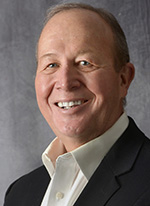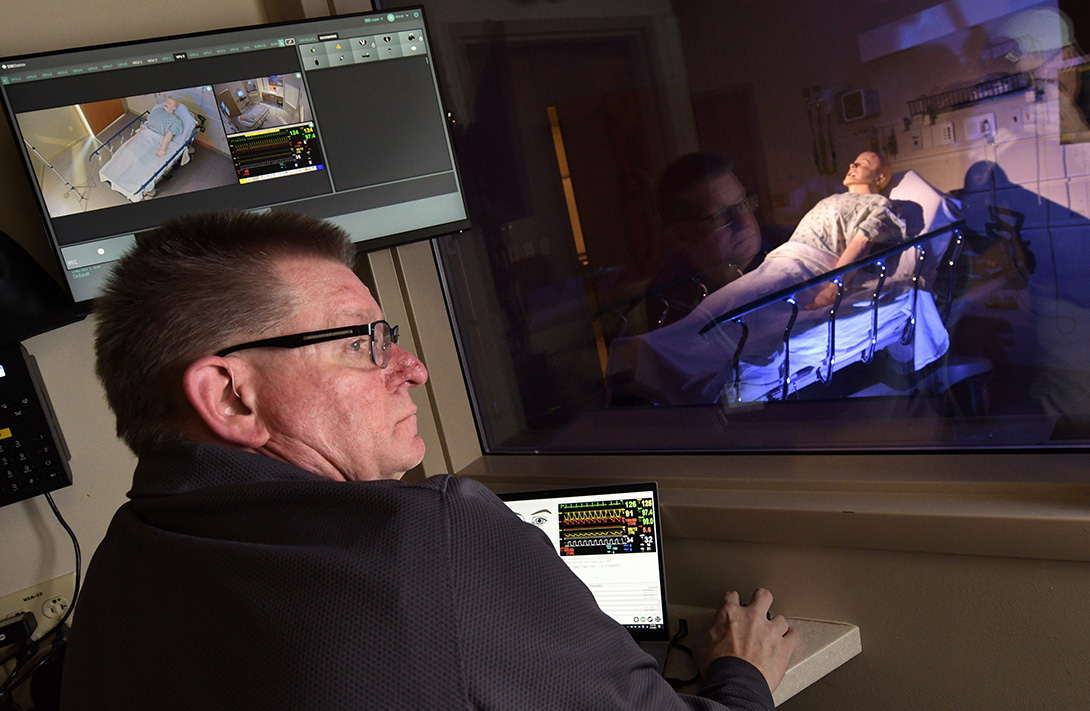Ten years of Jump Trading Simulation & Education Center innovations generate excitement about the next decade
As Jump Trading Simulation & Education Center commemorates its 10th anniversary this month, how do we measure its impact on Peoria and beyond?
Kelli Ballard of Washington measures it in the “breast cancer survivor” title she can claim after being diagnosed in her early 40s. That was in 2021, and she is “cancer free” and “doing well” today because of the OSF Innovation-supported tests — first the CancerIQ assessment, then genetic testing — that identified her high-risk, hereditary status. That prompted the MRI that discovered her early-stage cancer.
“You know, if I had waited six more months until my regular mammogram, it (the tumor) could have been … much more significant,” Ballard said afterwards, “so I was really grateful for the plan that was put in place.”
Dr. Richard Pearl was well aware of the use and value of simulation in aviation, and wanted to apply it to medicine
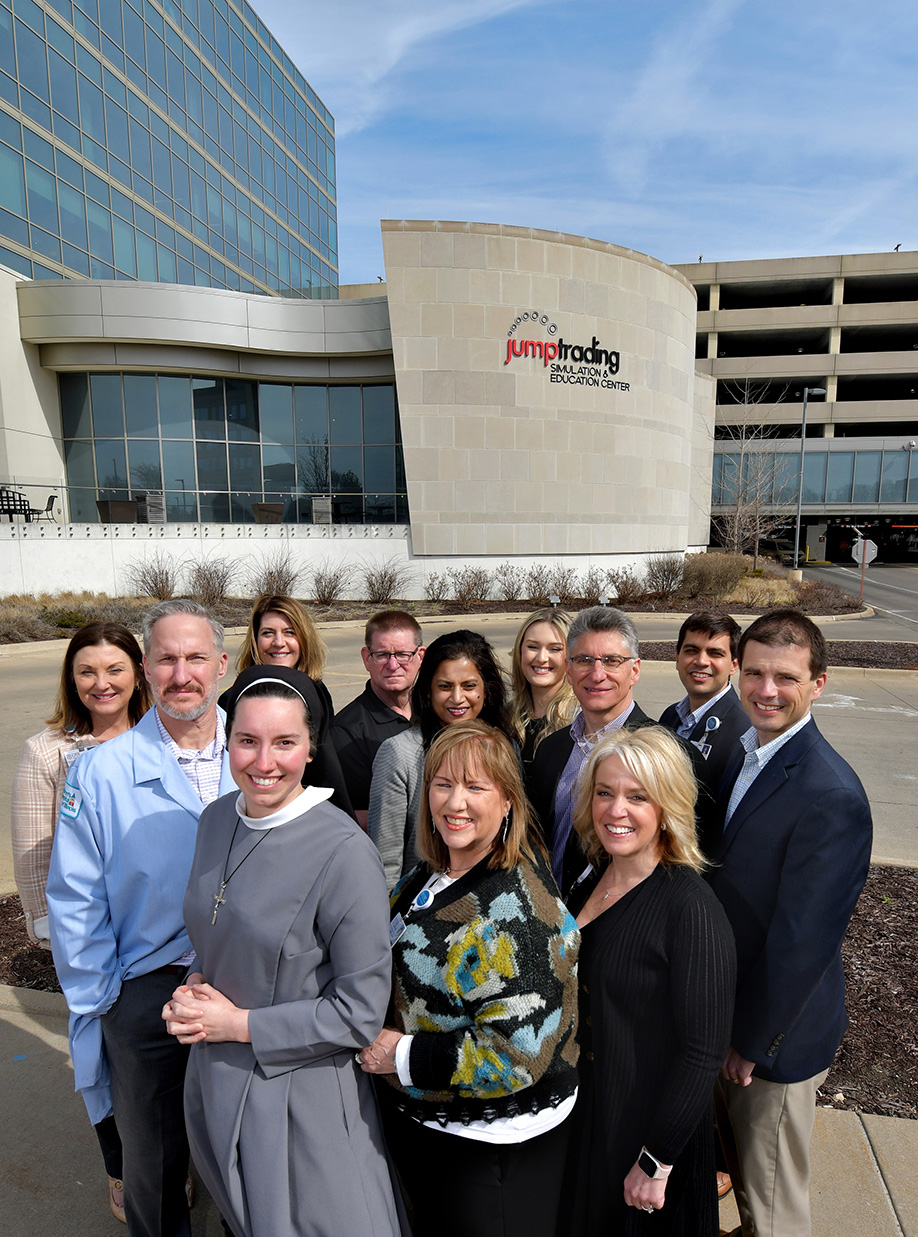
Myla Kramer of Coal City measures Jump’s influence in her life in the celebration of her 10th birthday. Born with congenital heart defects, Myla had her first operation at age 2 weeks and later suffered a stroke. Multiple follow-up surgeries were aided significantly by the 3D printing technology that helped Dr. Mark Plunkett clearly see the abnormalities in her heart, devise a plan of surgical attack, and give Myla a life that today has her enjoying sleepovers, dancing, singing and crafting with her friends.
The fruits of Jump also are measured in the multiple companies founded or fostered or financed through OSF Innovation, bringing jobs, revenue and a high-tech reputation to central Illinois.
Ultimately, it’s not just the facility at 1306 N. Berkeley Avenue, next door to OSF Saint Francis Medical Center, that matters.
“It’s world class not for the building but for the people who we recruited … that are just killing it inside that building,” said Dr. Richard Pearl, the retired surgeon in chief at OSF Children’s Hospital who had a big hand in making Jump happen. “That building makes a difference, not just to OSF HealthCare. It makes a difference around the country and around the world.”
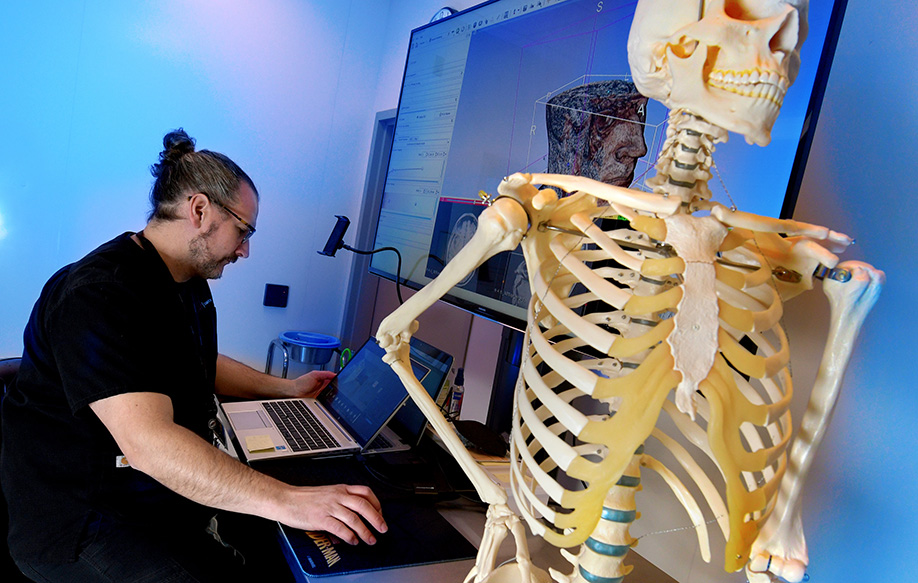
What is Jump?
The $51 million Jump Trading Simulation & Education Center opened on April 25, 2013, its construction precipitated by a $25 million donation from the DiSomma family, whose daughter had been a patient of Pearl’s following a serious accident. A former military helicopter pilot, Pearl was well aware of the use and value of simulation in aviation, wanted to apply it to medicine, and talked to his friend Bill DiSomma, a founding partner at Chicago-based Jump Trading, about that.
‘We design the future that we think is a desirable outcome and then work backwards’ — Dr. Jonathan Handler
Today, Jump the building houses OSF Innovation, a division of OSF HealthCare. In turn, OSF Innovation is the umbrella group under which OSF Ventures, Jump Simulation, Healthcare Analytics and OSF Innovation operate. The DiSomma Family Foundation, among others, has been generous over the years.
Spread across 168,000 square feet on six floors, the building on any given day hosts more than 500 doctors, nurses, engineers, designers, researchers, paramedics, innovators, entrepreneurs, academics, students, etc. The Center never closes.
OSF Innovation/Jump has three primary thrusts: the improvement of health care, here and everywhere, through technological advancement; education and training; and economic development.
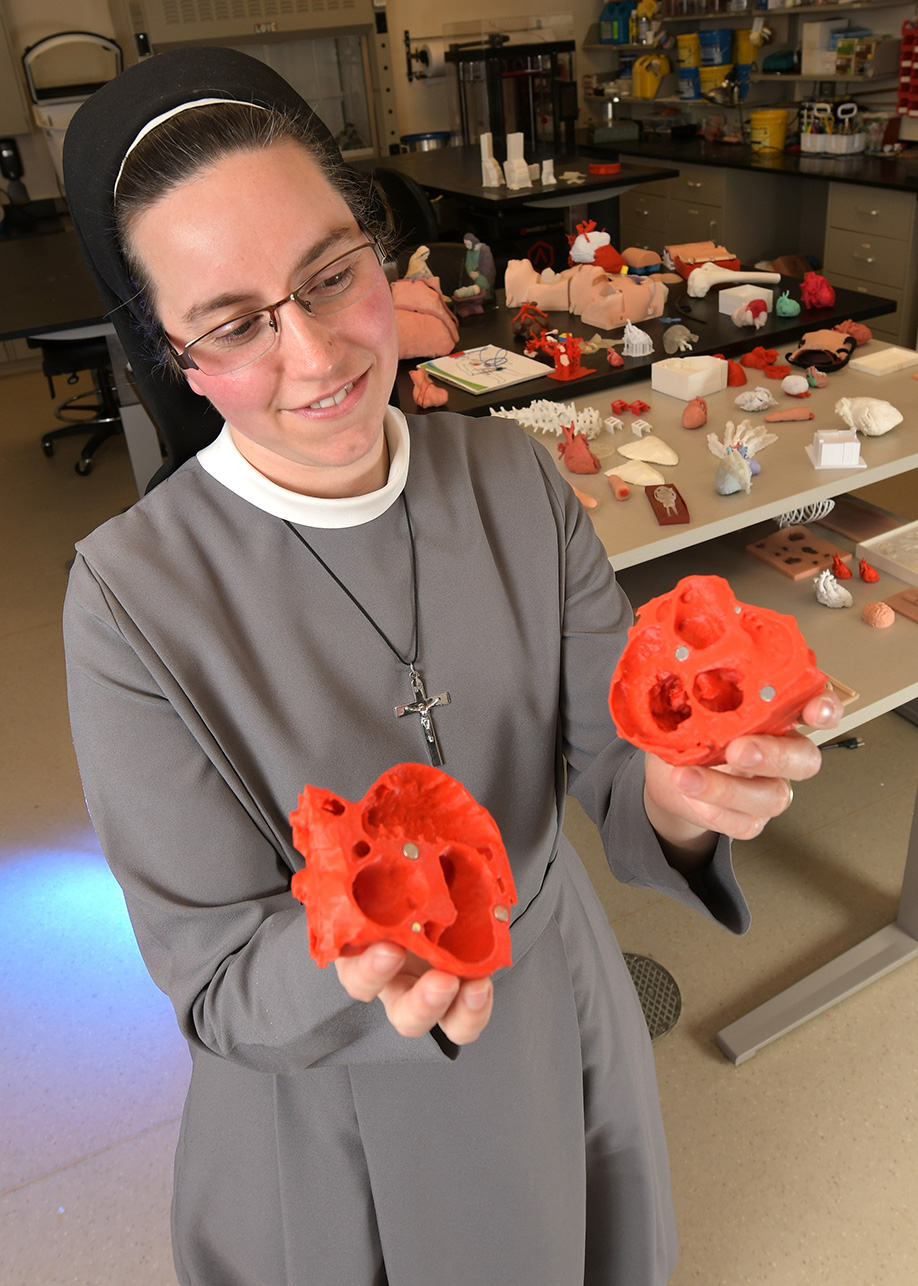
Health Care
Behind every decision made by the leaders at Jump is how it will affect patient care and improve health outcomes, said Dr. John Vozenilek, vice president and chief medical officer at OSF Innovation.
What that looks like inside Jump can seem like the stuff of science fiction.
Doctors strap on virtual reality (VR) goggles to immerse themselves inside a vital organ, the three-dimensional image of which has been scanned from an actual patient, allowing them to experience the operation they’ll soon perform for real. That specific technology, pioneered at OSF Innovation, offers insights that have significantly boosted surgeon confidence and even altered pre-operative strategies. Virtual and augmented reality technologies are not the wave of the future but the reality of the present at Jump.
Meanwhile, Artificial Intelligence (AI) is being used to gather massive amounts of data, which uncover patterns of behavior and social conditions that put people at risk. Predictive analytics anticipates what illnesses are coming based on a variety of patient factors — age, gender, income, family history, ZIP code, etc. — which allows health providers to respond accordingly regarding disease prevention, testing and treatment. The more information the machine gathers, the more it learns, the more refined its responses become, the more patient outcomes improve.
“We design the future that we think is a desirable outcome and then work backwards” to connect points A to B, process to end product, said Dr. Jonathan Handler, senior fellow at OSF Innovation.
Medicine, boosted by technology, is becoming preemptive, said Vozenilek.
“Health care today requires patients to seek us out,” he said. Tomorrow will bring “a system that anticipates the needs of patients and directs them to services, perhaps even before they realize they have a need … What we’re talking about here is flipping the access curve.”
A good example is mammography screening, said Handler.
“We saw that there were a number of women who were late on getting their mammography,” which put them at risk for having a breast cancer discovered “at a much later stage where the outcomes are not as good,” he said. “We were actually able to double the breast cancer screening rates” with proactive outreach efforts.
In a similar vein, a pilot program was rolled out to screen primary care patients with diabetes for diabetic retinopathy, the top cause of adult blindness in the U.S. One in five tested positive. That data pointed doctors in the right direction and got those patients to the ophthalmologists they needed, said Becky Buchen, senior vice president at OSF Innovation.
“You need … to capture the data to make sure that the device or the software or whatever … actually does what it says it does,” said Buchen.
Beyond that, what distinguishes OSF Innovation/Jump is the integration of these technologies and services under one roof, said Vozenilek.
“I haven’t seen anything like it in any location … across the country, and frankly, in my travels across the world,” he said. “There may be other simulation programs that are large and there may be other innovation centers that provide all kinds of … interesting new technologies … but ours is literally integrated.”
“If you don’t integrate it, it won’t make an impact to health care delivery,” added Buchen. Up next is doing that with OSF’s soon-to-be-completed Cancer Center.
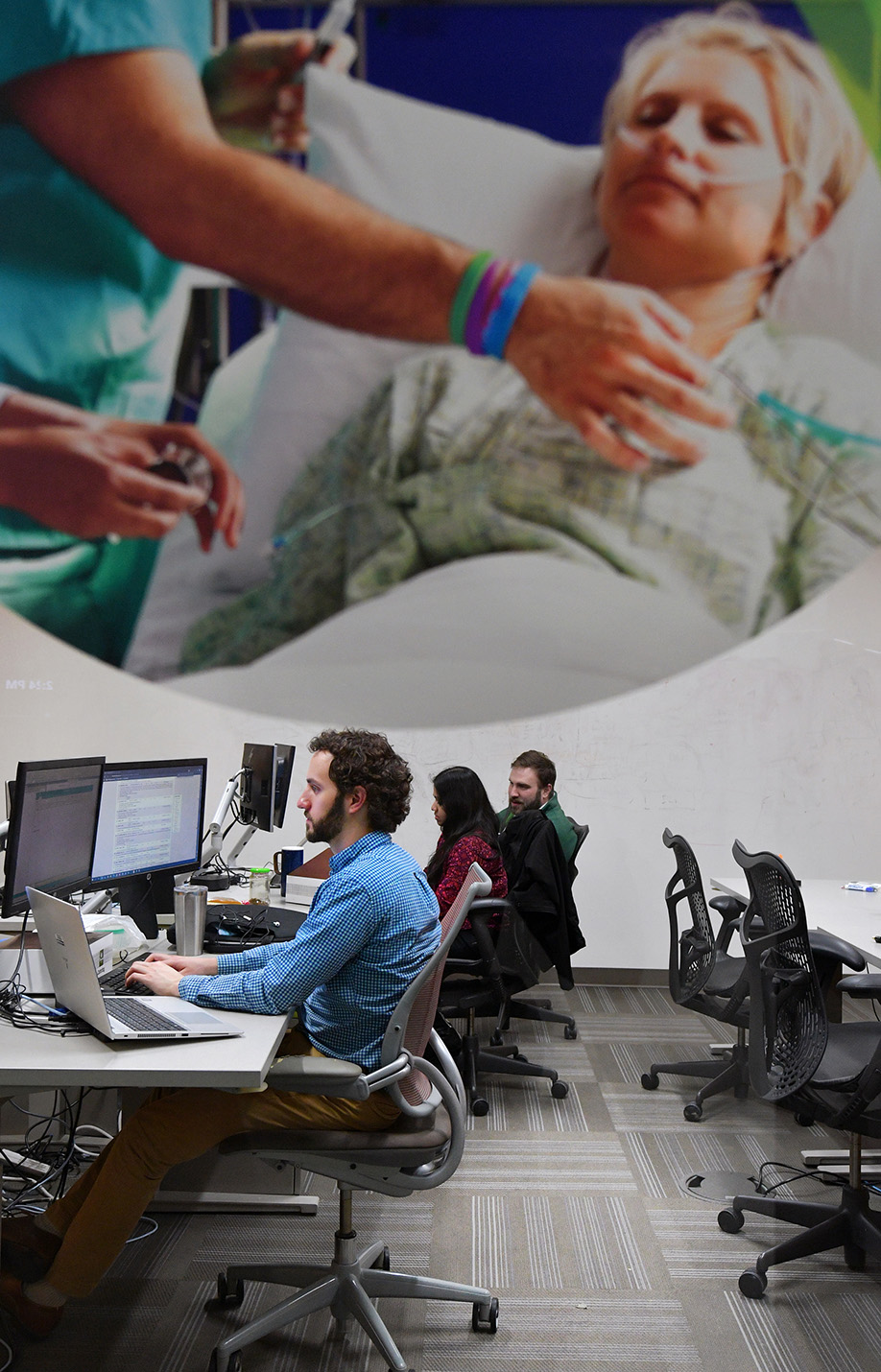
Training and Education
Since 2013, Jump has provided training to more than 1.1 million learners in “one of the world’s biggest” simulation centers. Meanwhile, the Jump STEAM (Science, Technology, Engineering, Art and Math) program has introduced 8,000 young people across 20 states, starting at age 6, to in-person, virtual and do-it-yourself experiences including a summer camp and overnight mini-medical school. The exposure can lead to later internships or jobs.
The whole point is to simulate real-world challenges that prepare students and professionals for the actual moment. Practice makes perfect.
Indeed, tour Jump with Noel Adams, vice president of academic collaborations and operations at Innovation Discovery Labs, and you’ll plant eyes on an interior ambulance bay outside of a built-to-realistic-scale senior apartment. How do you extricate an 85-year-old who falls in a very tight bathroom? Paramedics in training find out here first.
There’s a replica of an OSF operating room, right down to the pea-green, sky-blue and cream color scheme of the floor tile. What would happen if a fire, however remote the possibility, were to erupt in the operating room? Surgeons in training learn how to respond here first.
Meanwhile, med students work with patient actors who describe their symptoms, high-tech mannequins — they can cry, sweat — on which they can practice an intubation or IV insertion, and cadavers. “SimMom” takes them through a full birthing scenario.
In a nearby lab, a 3D printer churns out personalized organ replicas in plastic and resin. How might most of a liver be saved during a tumor removal? How might the blood vessels be re-routed? Where’s the best spot to deliver targeted radiation treatment? The models help doctors make those calls.
It’s not just about the delivery of top-notch medicine. How does a doctor tell a patient he or she has cancer? Jump provides that instruction, too.
Ultimately, it’s important to have a safe space to learn where mistakes can be made without consequences. Jump leaders are proud of their ability to produce “the most realistic environment you’ll ever get in simulation.”
Meanwhile, the whole building is designed “so people can bump into one another” and share ideas, said Adams. Given the pace of technological change, it’s “still a work in progress.”
Economic Development
OSF Ventures invests in start-ups, some 30 of them so far — 19 in its active portfolio — with $250 million in assets under management. Areas of strategic interest include health information technologies, medical devices, therapeutics, diagnostics and technology-enabled delivery solutions.
In terms of getting behind a company, “we try to stay close to what the Ministry’s strategy is,” said Taneja Mayank, vice president of OSF Ventures. So far, that has meant steering clear of biotech and pharmaceutical investments, though that could change with the Cancer Center coming on line, he said.
What’s in it for OSF are early access to emerging technologies and the solutions they bring. Entrepreneurs, meanwhile, get the capital they need and the expertise and mentorship to help them develop their products. Exo Works is coming along in that environment.
The Innovation Studio assists OSF employees, known as “Mission Partners,” in the development/commercialization of their ideas. DeviceTable, Medical Cart AR and Flight Path are examples.
Meanwhile, the Jump ARCHES (Applied Research for Community Health through Engineering and Simulation) grant program partners with OSF HealthCare, the University of Illinois Urbana-Champaign and the University of Illinois College of Medicine Peoria to provide seed money for promising technologies. With an endowment of $112.5 million, the program has awarded nearly $10.3 million to 143 projects. Enduvo, the cutting-edge, virtual and augmented reality company that came out of the Advanced Imaging and Modeling Lab at Jump, benefited from ARCHES. Also on OSF Innovation’s radar is research addressing aging in place, the opioid crisis, health equity and literacy.
Meanwhile, health care entrepreneurs are finding uses for these technologies in other industries. The future may include “taking apart aircraft engines for the Air Force” or “servicing heavy equipment with General Electric,” said Vozenilek.
“Jump is an important economic development asset in two ways. First, as the heart of OSF’s innovation efforts, it has the capacity to generate new businesses that become their own economic drivers,” said Chris Setti, CEO of the Greater Peoria Economic Development Council. “Second, Jump is a differentiator. In economic development, it is often about what your community does that is unique. Every region our size has hospitals. Only Peoria can lay claim to this incredible facility.”
A growing global reputation
The validation has come. In 2018, the Center received accreditation from the international Society for Simulation in Healthcare. Jump also can brag the prestigious American College of Surgeons’ seal of approval.
“There are dedicated people who come to work every day to … use their God-given talents to move patient outcomes in a forward way,” said Vozenilek. “We wake up every morning thinking about how we can do better, and there’s a whole building of people actually building solutions to make that happen.
“Now we are a beacon.”
OSF Ventures Investment Portfolio
Active
410 Medical – LifeFlow infusion system for critically ill patients in need of rapid volume resuscitation
Array Behavioral Care – Telepsychiatry
AVIA – Digital transformation
CancerIQ – “Precision medicine” in cancer prevention, early detection and treatment
Cardiosense – Digital biomarker platform for early cardiac disease
Digital Diagnostics – Artificial Intelligence diagnostics
DotCom Therapy – Online teletherapy
Endotronix – Chronic heart failure treatments
Epitel – Brain health monitoring
Euphrates Vascular – Vascular occlusion treatments, specifically clot-related acute ischemic stroke and heart attack
Exo Imaging – Reinventing ultrasound to diagnose, triage and treat patients
Gyant – Digital health, mobile apps and patient portals
Inflammatix – Molecular diagnostics, immune system treatments for infection
InsightRX – Precision medicine in pharmacology arena
PhotoniCare – Diagnostic tools for ear infections
Pieces Technologies – Artificial Intelligence interpreting patient information in real-time
Socially Determined – Social risk analytics
TailorMed – Financial-improvement technology for health care providers and patients
VIDA – Lung and respiratory care
Active Fund Investments
Ascension Ventures – Strategic health care venture fund with more than $1 billion under management
LRV Health – Innovation-focused venture capital fund, touching 1 in 3 U.S. health consumers
Graduates
BrightWater Medical – Devices for biliary and urinary blockage treatments (acquired by Merit Medical Systems)
CareSignal – Deviceless Remote Patient Monitoring platform (Lightbeam Health Solutions)
Current Health – Remote care management platform (Best Buy)
Gauss – Diagnosis-improving software for clinicians (Stryker)
Health Catalyst – Data and analytics technology
Level Ex – Video games for doctors (Brainlabs)
Paradigm Diagnostics – Personalized cancer diagnostics through genomic sequencing (Exact Sciences)
PatientWisdom – Digital health platforms (NRC)
Respiratory Motion – Minute ventilation monitoring, early warning system for respiratory collapse (Senzime)
SilverCloud Health – Digital platform for mental health delivery (Amwell)
